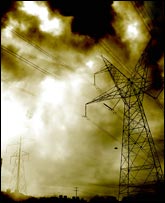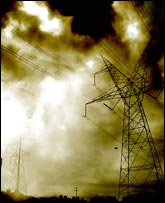Back at the turn of the millennium, the local government I was working for asked community members to contribute their vision of the municipality in the year 2025. As an environmental planner, I attended the community’s presentations with some interest.

It doesn’t have to be like this.
Photo: iStockphoto.
One group that responded was a gifted-students’ club from an elementary school. In their envisioned future, they imagined a community with only indoor parks. Beyond these parks, there would be no trees, no plants, no birds, and no animals. Freshwater would be gone, because lakes and streams would either be dried up or too polluted to support life; drinking water would have to be created from desalinization plants on the coast. In the future these children predicted, universities and colleges would be closed because everyone would learn — alone — through their personal computers.
As the children spoke, I sat with tears rolling down my cheeks. Had I really just heard what they’d said? Had the appreciative and encouraging municipal council heard the same thing? Why would children who lived in an idyllic natural environment — surrounded by trees, a rich diversity of plants and lush gardens, abundant wildlife including deer and cougars, large forested parks, and fish-bearing streams — imagine a future that was ecologically dead?
The answer may be because this is the future collectively envisioned by most everyone, including scientists, technology pundits, fiction and documentary filmmakers, writers, advertisers, video-game producers, and those of us whose careers are devoted to trying to protect the planet. Perhaps these children envisioned a future in which their community was dead because that’s the future they’re taught is inevitable.
I fully understand this despair. I hit a wall of it straight-on during my tenure as an environmental planner. In fact, I remember saying things like, “Yes, we will hit total ecological collapse, but our job is to ensure that as many species as possible live beyond it.” Now I see how harmful such words are.
Somehow, we need to begin to envision ecologically sound and socially just futures that reflect the great diversity of all beings, including humans. We must insist on having a say in what our futures look like. We do not have to accept the singular vision being created by those in power. This singular vision of the future is hyper-urban, with decaying cities, polluted air, and corporate and technological dominance. There is not a speck of nature. White men are still in charge. And then there are those damn flying cars.

On a swing and a prayer.
Photo: iStockphoto.
This isn’t the future I want, nor is it one I am working hard to create in my community. My vision of the future includes birds, trees, and clean flowing streams; organic, small-scale farms and lots of bicycles; conversations with neighbors at local stores and engaging educational institutions; clean air, strong women, diverse communities, truly democratic decision making, and happy children. No flying cars.
Some people will dismiss my vision as idealistic or unrealistic. But as scholar Ivana Milojevic of Metafuture reminds us, the dominant, dystopic vision of the future is seen as more “realistic” simply because it is talked about more, visualized more, and analyzed more. It is given infinite time and space in the media. It serves those in control; it is a continuation of their world. It’s endorsed by our corporate culture, because people who have been made to feel powerless to contribute to a better world simply give up, becoming self-absorbed in golf games, video games, war games. Becoming relentless consumers to fill the void — without challenging a thing.
Some people will say that my image of the future is counterproductive; that the doom and gloom is necessary to keep us all on our toes, to get us to respond to the warnings. I understand this. I have witnessed how politicians are unwilling or unable to take action until there is a crisis in front of them. But it doesn’t have to be an either/or. Yes, a good cautionary tale is a powerful thing. What makes me crazy is that a cautionary tale is all we get. We also need the alternative. We need hopeful visions to give us something to work for, as opposed to always working against something. We need a diverse crop of sustainable ways forward.
Back to the children who imagined their future as dead: I went to visit them a few months later, and told them about the work I was doing at the local level, some of the amazing work being done by teams of people at the regional and federal levels, by volunteers, and by nonprofit groups. And they completely shifted. They reworked their vision to include flowing streams, trees, birds, animals, and happy people. They just needed to know that there were adults making positive change toward a flourishing earth. And then they asked me how they could help. So we set to work on a plan to create a native garden in their schoolyard.
As peace activist Elise Boulding puts it, “The sheer difficulty of imagining a future sustainability different from the present is one of our greatest problems as a society.” Let’s create, in the space that Grist provides, a dialogue about our worries and our hopes. Let’s share stories about what is important for us to put in place for the future, and what’s happening in our communities now that provides hopeful ways forward. It will be hard work to imagine sustainable and just futures, but it is time to begin.



